数据操作
插入数据(记录): 用insert;
补充:插入查询结果: insert into 表名(字段1,字段2,...字段n) select (字段1,字段2,...字段n) where ...;
更新数据update
语法: update 表名 set 字段1=值1,字段2=值2 where condition;
删除数据delete:delete from 表名 where condition;
查询数据select:
单表查询:
语法:
select distinct 字段1,字段2... from 表名 where 条件 group by field having 筛选 order by field limit 限制条数;
关键字的执行优先级:
from where group by having select distinct order by limit
# 1.找到表:from
# 2.通过where指定的约束条件,去文件/表中取出一条条记录
# 3.将取出的一条条记录进程分组 group by,如果没有group by,则整体作为一组
# 4.将分组的结果进行having过滤
# 5.执行 select
# 6.去重
# 7.将结果按顺序排序:order by
# 8.限制结果的显示条数
简单查询:
#创建表 create table employee( id int not null unique auto_increment, name varchar(20) not null, sex enum('male','female') not null default 'male', # 大部分是男的 age int(3) unsigned not null default 28, hire_date date not null, post varchar(50), post_comment varchar(100), salary double(15,2), office int, depart_id int );
#插入记录 #三个部门:教学,销售,运营 insert into employee(name,sex,age,hire_date,post,salary,office,depart_id) values ('egon','male',18,'20170301','老男孩驻沙河办事处外交大使',7300.33,401,1), ('alex','male',78,'20150302','teacher',1000000.31,401,1), ('wupeiqi','male',81,'20130305','teacher',8300,401,1), ('yuanhao','male',73,'20140701','teacher',3500,401,1), ('liwenzhou','male',28,'20121101','teacher',2100,401,1), ('jingliyang','female',18,'20110211','teacher',9000,401,1), ('jinxin','male',18,'19000301','teacher',30000,401,1), ('成龙','male',48,'20101111','teacher',10000,401,1), ('歪歪','female',48,'20150311','sale',3000.13,402,2), ('丫丫','female',38,'20101101','sale',2000.35,402,2), ('丁丁','female',18,'20110312','sale',1000.37,402,2), ('星星','female',18,'20160513','sale',3000.29,402,2), ('格格','female',28,'20170127','sale',4000.33,402,2), ('张野','male',28,'20160311','operation',10000.13,403,3), ('程咬金','male',18,'19970312','operation',20000,403,3), ('程咬银','female',18,'20130311','operation',19000,403,3), ('程咬铜','male',18,'20150411','operation',18000,403,3), ('程咬铁','female',18,'20140512','operation',17000,403,3) ;
查询操作:
# 避免重复 distinct select distinct post from employee; # 通过四则运算查询 select name,salary*12 from employee; select name,salary*12 as Annual_salary from employee; select name,salary*12 Annual_salary from employee; # as Annual_salary是给 salary*12 起了一个别名;as 可省略 # 定义显示格式 (只是改变了显示格式,不会改变数据在数据库的保存格式) concat() 函数用于链接字符串 select concat("员工号:",id,",","姓名:",name) as info,concat("年薪:",salary*12) as annual_salary from employee; concat_ws() # 第一个参数可以作为分隔符 select concat_ws(":",name,salary*12) as annual_salary from employee;
where约束:
where语句中可以使用: 1. 比较运算符:>、<、>=、<=、 !=、( <>也表示不等于) 2. between 10 and 20 # 值在10到20之间 3. in(80,90,100) # 值是80或90或100 4. like "neo%" pattern可以是%或_, %表示任意个任意字符 _表示一个任意字符 5. 逻辑运算符:在多个条件直接可以使用逻辑运算符 and, or, not
主要用法:
where约束:
# 单条件查询: select name from employee where post="sale"; # 多条件查询: select name,salary from employee where post="teacher" and salary>10000; # 关键字between and select name,salary from employee where salary between 10000 and 20000; select name,salary from employee where salary not between 10000 and 20000; # 关键字 is Null:(判断某个字段是否为NULL不能用等号,要用is) select name,post_comment from employee where post_comment is Null; select name,post_comment from employee where post_comment is not Null;
# MySQL中,空字符串不等于 NULL,NULL是单独的数据类型;判断Null的时候必须用 is,如: where id is Null; # 关键字in集合查询: select name,salary from employee where salary in (3000,4000,9000); select name,salary from employee where salary not in (3000,4000,9000); # 关键字like模糊查询: 通配符:% select * from employee where name like "eg%"; 通配符:_ select * from employee where name like "ale_";
分组查询:group by
# 分组发生在where之后,即分组是基于where之后得到的记录而进行的
# 分组指的是将所有记录按照某个相同字段进行归类,比如针对员工信息表的职位分组,或者按照性别进行分组等
ONLY_FULL_GROUP_BY
# 查看MySQL 5.7默认的sql_mode如下: mysql> select @@global.sql_mode; #ONLY_FULL_GROUP_BY,STRICT_TRANS_TABLES,NO_ZERO_IN_DATE,NO_ZERO_DATE,ERROR_FOR_DIVISION_BY_ZERO,NO_AUTO_CREATE_USER,NO_ENGINE_SUBSTITUTION # 如果不设置ONLY_FULL_GROUP_BY,select的查询结果默认值是组内的第一条记录,这样显然是没有意义的; # 设置 ONLY_FULL_GROUP_BY模式: set global sql_mode="ONLY_FULL_GROUP_BY"; # 注意: ONLY_FULL_GROUP_BY 的语义就是确定 select target list中的多有的值都是明确语义,简单来说,在ONLY_FULL_GROUP_BY模式下,target list中的值要么来自聚合函数的结果,要么来自 group by list中的表达式的值(group_concat) # 去掉ONLY_FULL_GROUP_BY模式的设置方法: mysql> set global sql_mode='STRICT_TRANS_TABLES,NO_ZERO_IN_DATE,NO_ZERO_DATE,ERROR_FOR_DIVISION_BY_ZERO,NO_AUTO_CREATE_USER,NO_ENGINE_SUBSTITUTION';
聚合函数
# 聚合函数聚合的是组的内容;如果没有进行 group by分组,则默认所以记录是一组,所以此时也能用聚合函数 max() min() avg() sum() count()
示例:
select post,count(id) from employee group by post; # 只能查看分组依据的字段和使用聚合函数 # 注意:我们按照post字段分组,那么select查询的字段只能是post,想要获取组内的其他相关信息,需要借助函数 # group by关键字和 group_concat() 函数一起使用 select post,group_concat(name) as emp_members from employee group by post; # 按照岗位分组,并查看组内成员名 # group by和聚合函数一起使用 select post,avg(salary) as average_salary from employee group by post; # 按照岗位分组,并查看每个组的平均工资 # 没有分组的聚合函数: select count(*) from employee; select avg(salary) from employee;
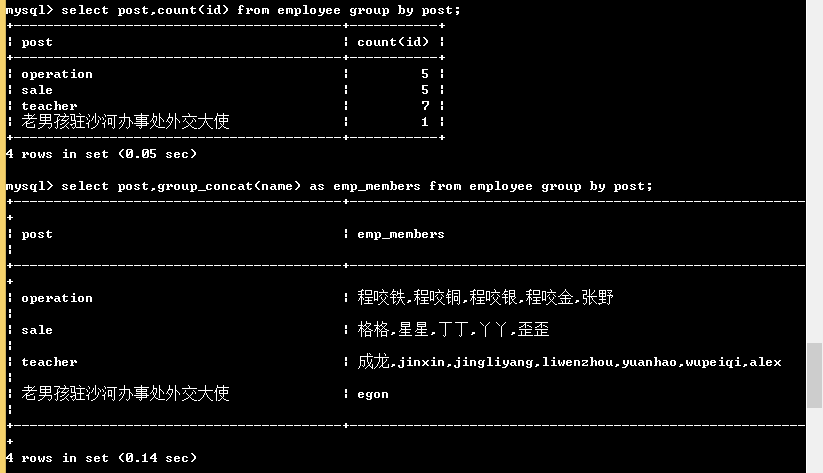
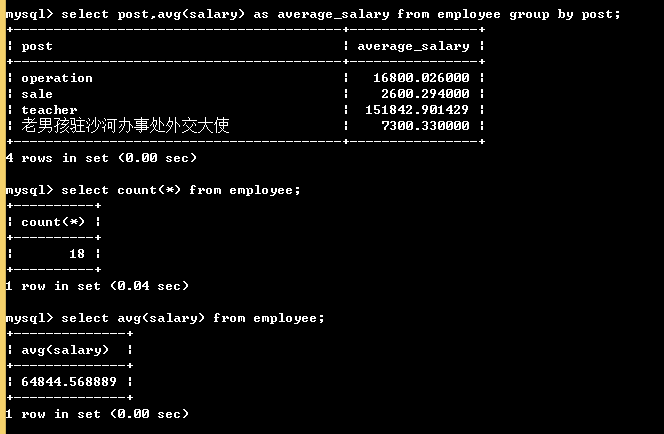
另外:如果我们用unique的字段作为分组的依据,则每条记录自成一组,这种分组也就没了意义;多条记录之间的某个字段值相同,该字段通常用来作为分组的依据
having过滤:
# having和where不一样的地方:
# 1. 执行优先级:where>group by >having
# 2. where 发生在分组 group by 之前,因而where中可以有任意字段,但是绝对不能使用聚合函数
# 3. having发生在分组group by之后,因而having中可以使用分组的字段,但却无法直接取到其他字段,其他字段需要使用聚合函数
having中也可以用where中的逻辑,例如 and,or 等;having 跟where 用法一样,只不过having是分组之后的过滤
错误用法示例:
mysql> select * from employee having salary > 100000; ERROR 1463 (42000): Non-grouping field 'salary' is used in HAVING clause # 报错; having前面必须要有 group by mysql> select post,group_concat(name) from employee group by post having salary > 10000; #错误,分组后无法直接取到salary字段 ERROR 1054 (42S22): Unknown column 'salary' in 'having clause'
正确用法如下:
# 1. 查询各岗位平均薪资大于10000的岗位名、平均工资 select post,avg(salary) as average_salary from employee group by post having avg(salary) > 10000; # 2. 查询各岗位平均薪资大于10000且小于20000的岗位名、平均工资 select post,avg(salary) as average_salary from employee group by post having avg(salary) between 10000 and 20000;
# having的用法就是英语里面的定语从句
order by排序:
select * from employee order by 字段 asc; #升序排;默认 select * from employee order by 字段 desc; #降序排 order by 字段1 asc,字段2 desc; # 先按照字段1升序排,如果字段1的值相同则按照字段2降序排 e.g. select * from employee order by age asc,id desc;
执行顺序证明:
select distinct post,count(id) as emp_number from db1.employee where salary>1000 group by post having count(id)>2 # having中的count(id)不能用 emp_number 来代替,因为是先执行 having后执行 distinct,所以此时还没有 emp_number这个东西 order by emp_number desc # order by 中的count(id) 可以用 emp_number来代替,因为是先执行distinct后执行的order,执行完distinct之后就已经有了 emp_number ; # 所以,优先级顺序是: from > where > group by > having > distinct > order by
limit限制条数:不管是书写顺序还是执行顺序,limit都是在最后
select * from employee limit 3; # 3是限制条数;默认初始位置为0 select * from employee limit 0,3; # 从0开始打印3个 (不包含0) # 工资最高的那三个人的信息: select * from employee order by salary desc limit 3; # 分页打印: select * from employee limit 0,5; select * from employee limit 5,5; select * from employee limit 10,5; select * from employee limit 15,5;
正则查询regexp: (regexp应该是regular expressioin的缩写吧)
# select * from employee where name regexp "^jin.*(g|n)$"; # jin开头,并且 g或者n结尾
多表查询:(本质就是连表,通过连表将多张有关系的表连接在一起,得到一张虚拟表)
先建两个表,用于下面所有的操作测试
# 建表 create table department( id int, name varchar(20) ); create table employee( id int primary key auto_increment, name varchar(20), sex enum('male','female') not null default 'male', age int, dep_id int ); #插入数据 insert into department values (200,'技术'), (201,'人力资源'), (202,'销售'), (203,'运营'); insert into employee(name,sex,age,dep_id) values ('egon','male',18,200), ('alex','female',48,201), ('wupeiqi','male',38,201), ('yuanhao','female',28,202), ('liwenzhou','male',18,200), ('jingliyang','female',18,204) ;
连接方式:
# 1. 内连接: 只取两张表的共同部分 select * from employee inner join department on employee.dep_id = department.id; # 表employee内连接到表department,按照表employee中dep_id字段等于表department中id字段的方式连接 # 2. 左链接:在内链接的基础上保留左表的记录 select * from employee left join department on employee.dep_id = department.id; # 3. 右链接:在内链接的基础上保留右表的记录 select * from employee right join department on employee.dep_id = department.id; # 4. 全外链接: 在内连接的基础上左右两表的记录都保存 select * from employee left join department on employee.dep_id = department.id union select * from employee right join department on employee.dep_id = department.id;
内连接:

左连接:

右连接:

全外连接:

多表查询示例:
笛卡尔积:
select * from employee,department;
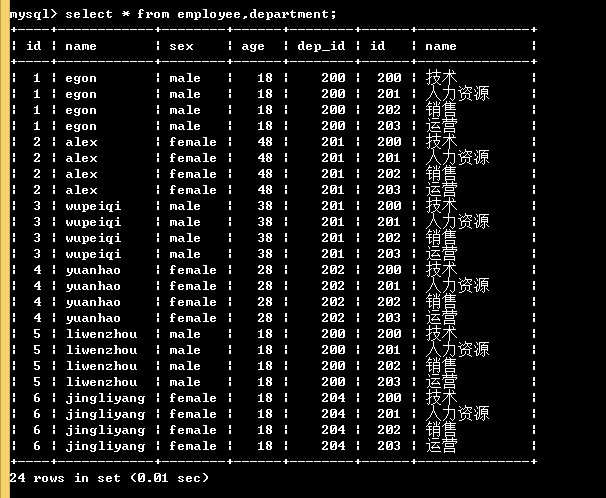
多表查询原理:
select * from employee inner join department on employee.dep_id = department.id; # 通过这种方式能得到一个整合了表employee和表department的虚拟表

# 再对上面得到的虚拟表进行操作 select department.name,avg(age) from employee inner join department on employee.dep_id = department.id group by department.name having avg(age) > 30;
# 多表查询:把有关系的表通过连接的方式拼成一个整体(虚拟表),进而进行相应的关联查询(因为此时已经是一长表了)
SQL逻辑查询语句执行顺序:
一、SELECT语句关键字的定义顺序:
select distinct <select_list> from <left_table> <join type> join <right_table> on <join_condition> where <where_condition> group by <group_by_list> having <having_condition> order by <order_by_condition> limit <limit_number>;
二、SELECT语句关键字的执行顺序:
第一步: from <left_table> 第二步: on <join_condition> 第三步: <join_type> join <right_table> 第四步: where <where_condition> 第五步: group by <group_by_list> 第六步: having <having_condition> 第七步: select 第八步: distinct <select_list> 第九步: order by <order_by_condition> 第十步: limit <limit_number>
具体可参考: http://www.cnblogs.com/linhaifeng/articles/7372774.html
子查询:
1. 带 in 关键字的查询:
# 查询平均年龄在25岁以上的部门名 select name from department where id in (select dep_id from employee group by dep_id having avg(age) > 25); # (select dep_id from employee group by dep_id having avg(age) > 25)会有一个返回值,符合过滤条件的 dep_id;where id in (select dep_id from employee group by dep_id having avg(age) > 25) 就类似于 where id in (1,2,3) # 查看技术部员工姓名 select name from employee where dep_id = (select id from department where name="技术"); # 查看不足一人的部门名 # 分析:不足1人就是没有人 select name from department where id not in (select distinct dep_id from employee) ; # (select distinct dep_id from employee) 通过去重得到有人的部门id, where id not in ...取反,即 department的id没有在有人的部门id里面
2. 带比较运算符的子查询
# 查询大于所有人平均年龄的员工名和年龄 select name,age from employee where age > (select avg(age) from employee); # where后面不能直接写成 where age > avg(age),因为where里面不能使用聚合函数;所以先通过 (select avg(age) from employee)拿到 avg(age)
3. 带exists关键字的子查询 (exists是用于判断是否存在的,返回的类似于bool值)
select * from employee where exists (select id from department where name="技术"); # 如果(select id from department where name="技术")成立(存在,此时where exists语句返回True),就执行 select * from employee; 如果不存在,就不执行select * 语句
# exists也可以not 取反
select 查询语句可以用括号括起来,再用 as 起一个别名,就能当作一张表(临时表)来使用,如下:
select * from (select name,age,sex from employee) as t1;
以另外一张employee表为例说明:
# 查询每个部门最新入职的那名员工
报错: select * from employee as t1 inner join (select post,max(hire_date) from employee group by post) as t2 on t1.post=t2.post where t1.hire_date=t2.max(hire_date); # 报错原因:where中不能有聚合函数
正确: select * from employee as t1 inner join (select post,max(hire_date) as new_hire from employee group by post) as t2 on t1.post = t2.post where t1.hire_date = t2.new_hire; # 取别名后就是单纯的调用了
权限管理:略
Navicat工具:
批量加注释:ctrl+?键
批量去注释:ctrl+shift+?键
pymysql模块
pymysql基本使用:
通过pymysql模块能够在python程序中操作MySQL数据库;pymysql模块本质就是一个套接字客户端软件
import pymysql username = input("username>>>:").strip() password = input("password>>>:").strip() # 建链接 conn = pymysql.connect(host="192.168.18.2",port=3306,user="root",password="123",db="db4",charset="utf8") # 得到一个链接对象; # charset中的utf8不能加 - ,因为mysql中没加 # 拿到一个游标(cursor) cursor = conn.cursor() # 得到一个游标对象 # 给游标提交命令,执行sql语句 sql = "select * from userinfo where username='%s' and password='%s' " %(username,password) # sql语句中的username和password要和db4.userinfo这张表中的字段一样
print(sql)
rows = cursor.execute(sql) # 把sql语句提交给cursor去执行; # execute() 不是执行的结果,而是受影响的行数(rows) cursor.close() conn.close() # 把资源回收 # 进行判断 if rows: print("登录成功") else: print("登录失败")
但上面的程序有一个漏洞:
# 在MySQL中, --空格 后面的内容都会被注释掉(两个横杠后面跟一个空格),所以在你的python程序中输入: username>>>:neo' -- xxxx 不输密码,也能够成功登录
并且
# 输入: username>>>:xxx' or 1=1 -- hahahaah 不输密码,也可以登录

解决办法:利用pymysql模块的sql注入
pymysql模块之sql注入:
import pymysql username = input("username>>>:").strip() password = input("password>>>:").strip() # 建链接 conn = pymysql.connect(host="192.168.18.2",port=3306,user="root",password="123",db="db4",charset="utf8") # 拿到一个游标(cursor) cursor = conn.cursor() # 得到一个游标对象 # 给游标提交命令,执行sql语句 sql = “select * from userinfo where username=%s and password=%s” # 不要自己拼接字符串,利用 pymysql的execute拼接字符串; # 占位符也不要再加引号 rows = cursor.execute(sql,(username,password)) # 第一个参数还是传入要执行的sql语句;第二个参数传入一个元组,元组里面放入sql语句里面的占位符,通过这种方式拼接字符串,能把其中的特殊字符处理掉 cursor.close() conn.close() # 进行判断 if rows: print("登录成功") else: print("登录失败")
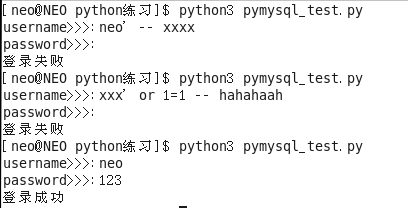
pymysql模块之增删改:
import pymysql # 建链接 conn = pymysql.connect(host="192.168.18.2",port=3306,user="root",password="123",db="db4",charset="utf8") # 拿到游标 cursor = conn.cursor() # 执行sql语句 # 增删改 sql = "insert userinfo(username,password) values(%s,%s)" print(sql) rows = cursor.execute(sql,("abc","123")) conn.commit() # 修改的数据要生效,必须在cursor.conn关闭之前 conn.commit() # 关闭 cursor.close() conn.close()
插入多条记录:
# 插入多条记录 rows = cursor.executemany(sql,[("egon1","456"),("egon2","123"),("egon3","789")]) # 利用executemany(),列表中放入多个元组
lastrowid用法:查询你即将插入的数据是从第几行开始的
import pymysql # 建链接 conn = pymysql.connect(host="192.168.18.2",port=3306,user="root",password="123",db="db4",charset="utf8") # 拿到游标 cursor = conn.cursor() # 执行sql语句 sql = "insert userinfo(username,password) values(%s,%s)" # 插入多条记录 rows = cursor.executemany(sql,[("egon7","456"),("egon8","123"),("egon9","789")]) # 利用executemany(),列表中放入多个元组 print(cursor.lastrowid) # cursor.lastrowid 是你上面代码插入的时候,是从第几行开始插入的 conn.commit() # 修改的数据要生效,必须在cursor,conn关闭之前 conn.commit() # 关闭 cursor.close() conn.close()

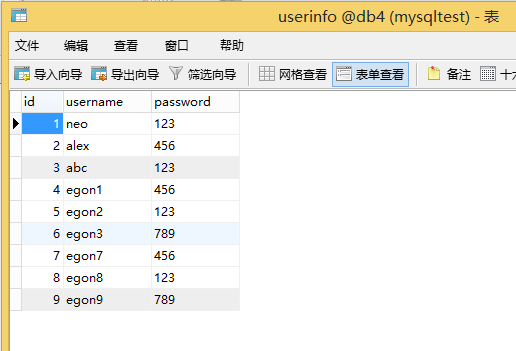
删改就是把上述例子中的sql语句改成删改的sql语句就行了
pymysql模块之查询
import pymysql conn = pymysql.connect(host="192.168.18.2",port=3306,user="root",password="123",db="db4",charset="utf8") cursor = conn.cursor(pymysql.cursors.DictCursor) # cursor()中如果什么都不写,查询出来的数据是元组的形式;如果指明了 pymysql.cursors.DictCursor,查询结果是字典的形式,字典的key是表的字段 rows = cursor.execute("select * from userinfo") print(cursor.fetchone()) print(cursor.fetchone()) print(cursor.fetchone()) print(cursor.fetchone()) print(cursor.fetchone()) print(cursor.fetchone()) print(cursor.fetchone()) print(cursor.fetchone()) # 运行过程分析: cursor.execute("select * from userinfo")给MySQL服务端发送了查询语句,服务端查完之后把查询结果返回给服务端,服务端收到后把全部结果放到了管道里面,fetchone()一次就取出一条结果;取完之后再去就是None # fetch还有两种用法: # 1. cursor.fetchmany(3) # 一次取3条;取出来的结果放到一个列表中,由于已经指定了 pymysql.cursors.DictCursor,所以列表中是一个个字典 # 2. cursor.fetchall() # 一次全部取完,结果放到一个列表中;取完之后再fetchall会得到一个空列表 cursor.close() conn.close()
fetchone:
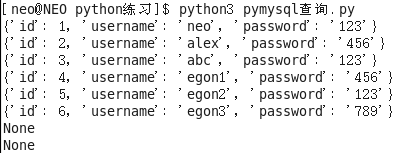
fetchmany:

fetchall:

cursor.scroll用法:移动管道中的光标
import pymysql conn = pymysql.connect(host="192.168.18.2",port=3306,user="root",password="123",db="db4",charset="utf8") cursor = conn.cursor(pymysql.cursors.DictCursor) rows = cursor.execute("select * from userinfo") # cursor.scroll(3,mode="absolute") # 相对绝对位置移动:从管道最开始的位置跳过去3条 # cursor.scroll(3,mode="relative") # 相对当前位置移动:从光标所在管道的当前位置跳过去3条 cursor.scroll(3,mode="absolute") print(cursor.fetchone()) # 跳过前三条,直接从第四条开始取 cursor.close() conn.close()
相对绝对位置移动

相对当前位置移动
print(cursor.fetchone()) cursor.scroll(3,mode="relative") print(cursor.fetchone()) # 从第二条开始跳过取3个开始取

MySQL内置功能:
视图:
视图一个虚拟表(非真实存在),其本质是【根据SQL语句获取动态的数据集,并为其命名】,用户使用时只需使用【名称】即可获取结果集,可以将结果当作表来使用;但是不推荐使用视图,因为扩展SQL极不方便
创建视图:
# 语法: create view 视图名称 as sql语句 create view teacher_view as select tid from teacher where tname='李平老师'; #于是查询李平老师教授的课程名的sql可以改写为 mysql> select cname from course where teacher_id = (select tid from teacher_view);
修改视图(往视图中插入数据),原始表也跟着改
修改视图:
语法:ALTER VIEW 视图名称 AS SQL语句 mysql> alter view teacher_view as select * from course where cid>3;
删除视图:
# 语法:DROP VIEW 视图名称 DROP VIEW teacher_view
函数:
date_format(date相关字段,date格式) # 第一个参数写date的相关字段,第二个参数写所需要的date格式,如:"%Y-%m-%d";
datediff(current_date,sale_date) # current_date和sale_date之间的天数间隔
示例:

select item_id,count(distinct date_format(sale_date,"%Y-%m-%d")) as day_num from txn where datediff(current_date,sale_date) <=10 group by item_id having day_num >=5 order by day_num desc; # current_date也是一个函数,表示当天的日期
控制流函数:
1、case when condition1 then result1 ... else default end
# 如果 conditionN是真,则返回 resultN,否则返回default
2、case test when value1 then result1... else default end
# 如果test 和valueN相等,则返回 resultN,否则返回default
如下:
查询班级信息,包括班级id、班级名称、年级、年级级别(1为低年级,2为中年级,3为高年级)
select cid as 班级id,caption as 班级名称,gname as 年级, (case grade_id when 1 then "低" when 2 then "中" else "高" end) as "年级级别" from class inner join class_grade on class.grade_id=class_grade.gid;